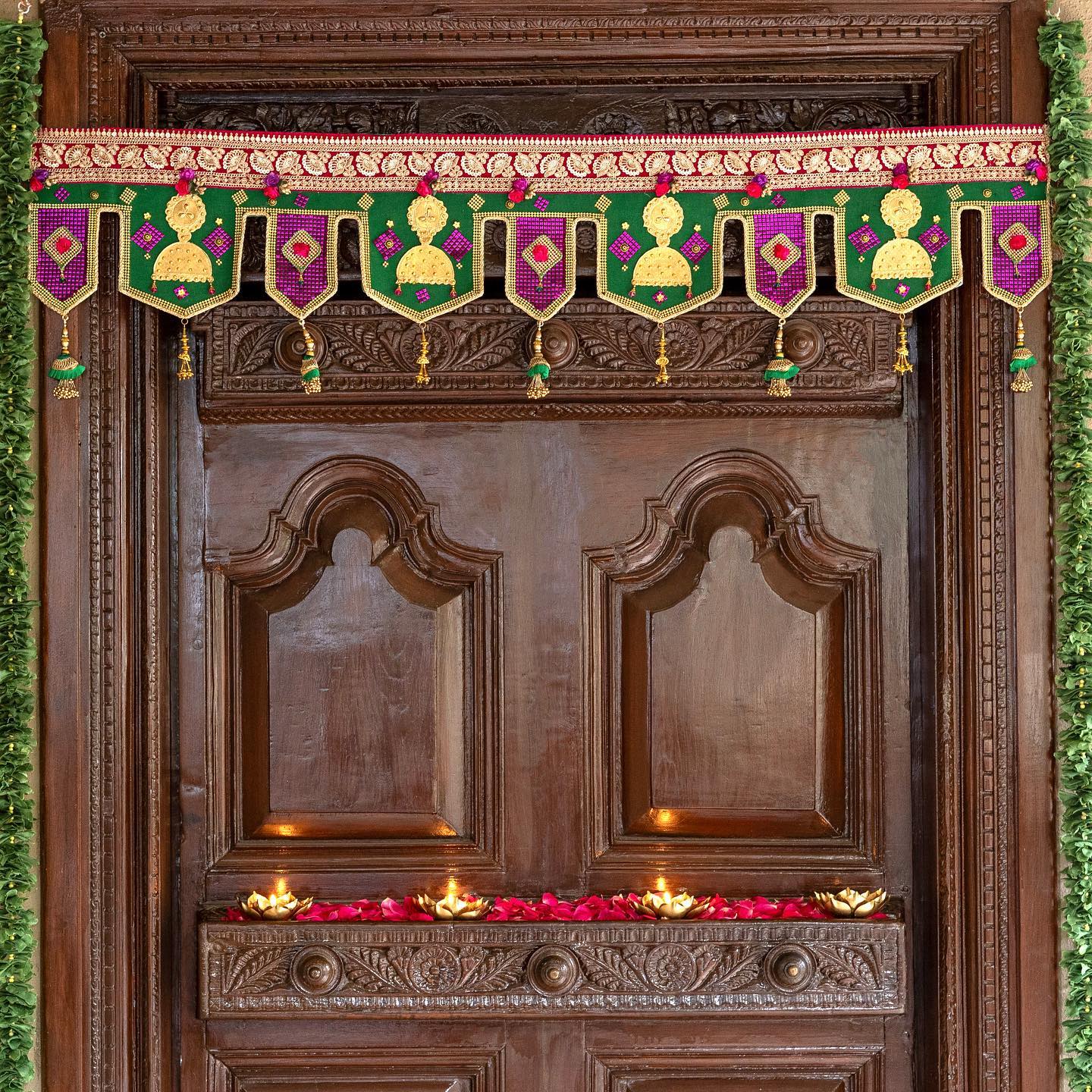Walk into any modern Indian home today, and you will notice Bandhanwar pieces are showing up in places they were never meant to be.
Above headboards, on the living room walls, and behind work desks. Anywhere but the
traditional doorway.
The shift started quietly. A few interior design enthusiasts began experimenting.
They hung their festival torans year-round. They treated them like textile art instead of seasonal decorations. The results surprised everyone.
Something interesting is happening in Indian homes right now. The humble bandhanwaris breaking free from its designated spot. Read to know more.
1. Breaking Free from Doorway Duty
Contemporary art galleries across Bangalore and Delhi feature installations with cascading
textiles, layered florals, and hanging elements that catch the breeze. These pieces look
expensive and exclusive.
Yet traditional Indian homes have displayed similar aesthetics for centuries.
The difference lies in placement and perception. Galleries call it installation art. Homes call it seasonal door decoration.
Young homeowners buying bandhanwar online are bridging this gap. They see beautiful
craftsmanship that deserves daily visibility, not just festival appearances.
2. Transforming Blank Walls Instantly
A designer bandhanwar provides an instant solution without drilling multiple holes or hiring professionals for a long, empty wall in the living room
Some homeowners have mounted the Shubh Laabh Toran horizontally above bedroom
headboards.
The yellow marigolds and silk flowers create an unexpected canopy effect. Nobody identifies it as a traditional toran.
The shift happens when people stop seeing these pieces as door-specific decorations and start recognising them as versatile wall art.
3. Mixing Media Like Modern Galleries
Art galleries group different elements together deliberately. A painting hangs beside a
photograph next to a sculpture.
The variety creates visual interest and conversation.
Home walls can embrace this same approach. Contemporary prints occupy one section. The Chandini Toran, with its yellow silk roses and shimmering gold-white beads, fills another. The combination adds depth and dimension to flat surfaces.
Unlike static frames, a bandhanwar responds to air movement. It shifts with ceiling fans and open windows. The wall gains life and motion instead of remaining frozen in place.
4. Adding Colour Without Paint Commitment
Interior styling often involves lengthy debates about wall colours and paint samples.
The Parnita Toran against a soft pink wall provides instant colour harmony. The pink pom-poms and pearl-white beads create cohesion. Fabric tassels add textural interest without any permanent changes.
Treating torans as three-dimensional colour palettes opens new decorating possibilities.
Shopping bandhanwar online becomes similar to selecting artwork, with the added benefit of actual texture and movement.
Some designers rotate their collections with seasons.
February might bring out the Saanjh Toran with red tassels and golden accents. The room
atmosphere transforms without adjusting thermostats or repainting walls.
5. Creating Statement Backdrops
Photography studios and prop stylists specifically request bandhanwar toran pieces for
professional shoots. These elements add cultural depth and visual interest without
overwhelming the primary subject.
Home spaces benefit from the same principle. The awkward corner behind a reading chair
becomes intentional with a cascading piece. Regular spaces gain editorial polish.
Work-from-home setups improve dramatically with strategic placement.
The Embellished Green Toran positioned behind a desk catches light during video calls.
Sequins shimmer. Lace patterns add depth.
Motifs create talking points. Colleagues notice the interesting backdrop without recognising it as traditional decor.
6. Embracing Asymmetrical Placement
Traditional rules demand perfect centring. Contemporary design celebrates intentional off-centre positioning.
Torans work beautifully in unexpected locations.
Above a bar cart, they add festive energy. Beside a tall bookshelf, they soften hard edges. Near windows, natural breezes activate movement.
The Purple Shola Toran transforms completely when afternoon sunlight filters through purple and pink silk flowers, creating shifting shadow patterns.
Open-plan homes particularly benefit from suspended pieces. They suggest spatial boundaries without constructing actual walls.
The kitchen flows into the dining area with a visual marker that maintains connection while defining zones.
7. Pairing Heritage with Modern Elements
Contemporary galleries mix traditional and modern constantly. Ancient sculptures sit beside digital displays. Hand-woven textiles hang near minimalist paintings.
Home styling can adopt this curatorial approach. Family photographs gain warmth when
displayed against a toran backdrop.
These pieces create depth behind black-and-white portraits. Heritage literally frames personal history.
Alternatively, modern geometric sculptures on shelves pair strikingly with bandhanwar pieces hung above them.
Clean lines meet organic curves. Minimalist forms contrast with abundant florals. Neither
element compromises. Both become more prominent through juxtaposition.
8. Maximising Daily Visibility
Door placement creates a fundamental problem. People walk under bandhanwar, not past them.
These pieces receive only passing glances during their brief seasonal display.
Wall positioning changes the entire relationship.
A toran becomes something visible multiple times daily. Morning light plays with beads.
Afternoon breezes shift silk flowers.
Evening lamplight creates new shadow plays. The piece integrates into everyday life instead of appearing briefly during festivals.
This approach doesn't abandon tradition. It actually honours craftsmanship by providing
constant appreciation rather than periodic acknowledgement.
Expanding Shopping Perspectives
Buying pieces removes traditional constraints. No relatives questioning unconventional choices.
No obligation to replicate inherited decorating patterns. Pure design exploration becomes possible.
Each Maeva piece carries potential beyond doorways.
Fabric, beads, flowers, and tassels translate beautifully into contemporary spaces. These items have always been artistic creations. Modern placement finally gives them appropriate recognition.
Starting Small, Thinking Big
Most homes contain at least one wall that feels incomplete. The space behind the sofa lacks interest. The hallway stretch needs something. The dining console area looks bare.
Any location can accommodate these pieces. They warm up cool-toned rooms, soften
hard-edged modern furniture, and bring traditional textile art into minimalist spaces.
Traditional wisdom created beautiful objects. Contemporary thinking allows daily enjoyment of that beauty. Walls everywhere are ready for this artistic evolution.
Check Maeva’s Bandhanwar Torans collection today!

